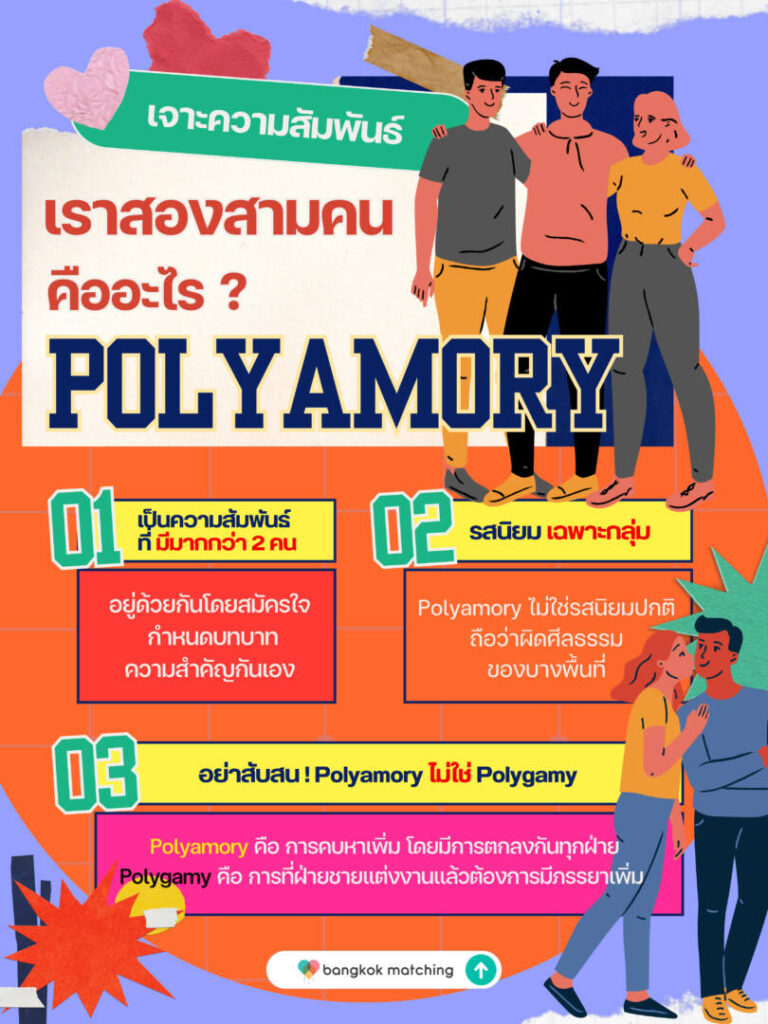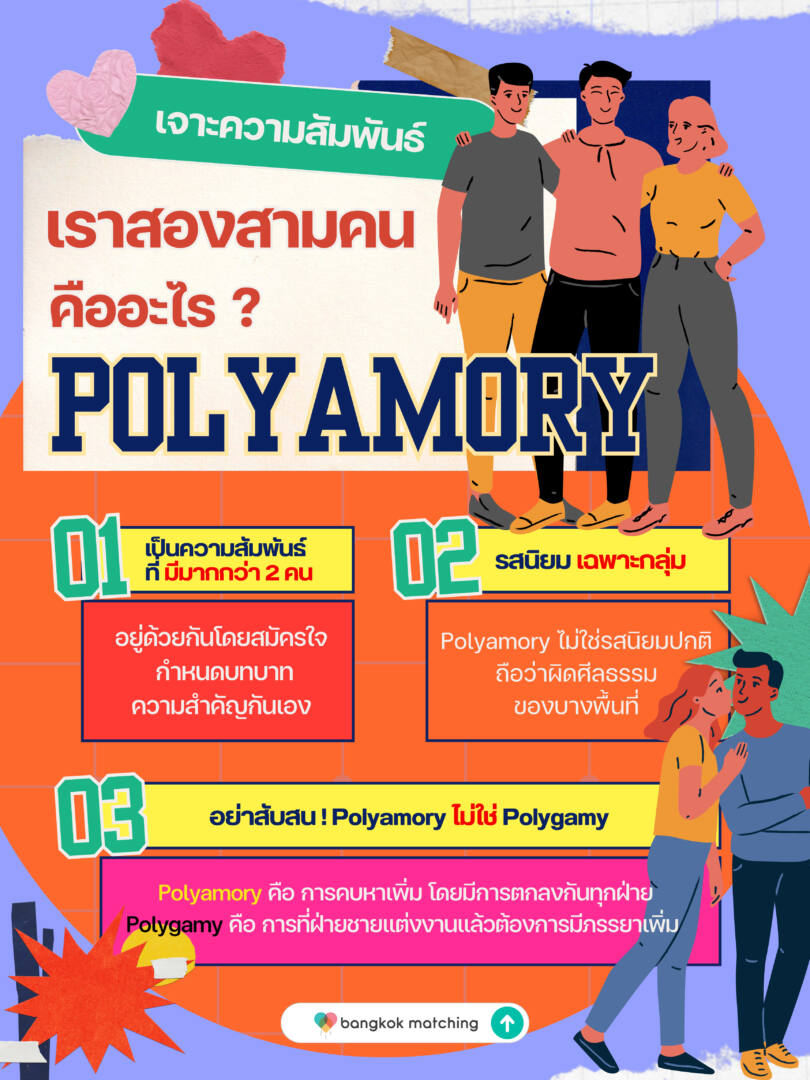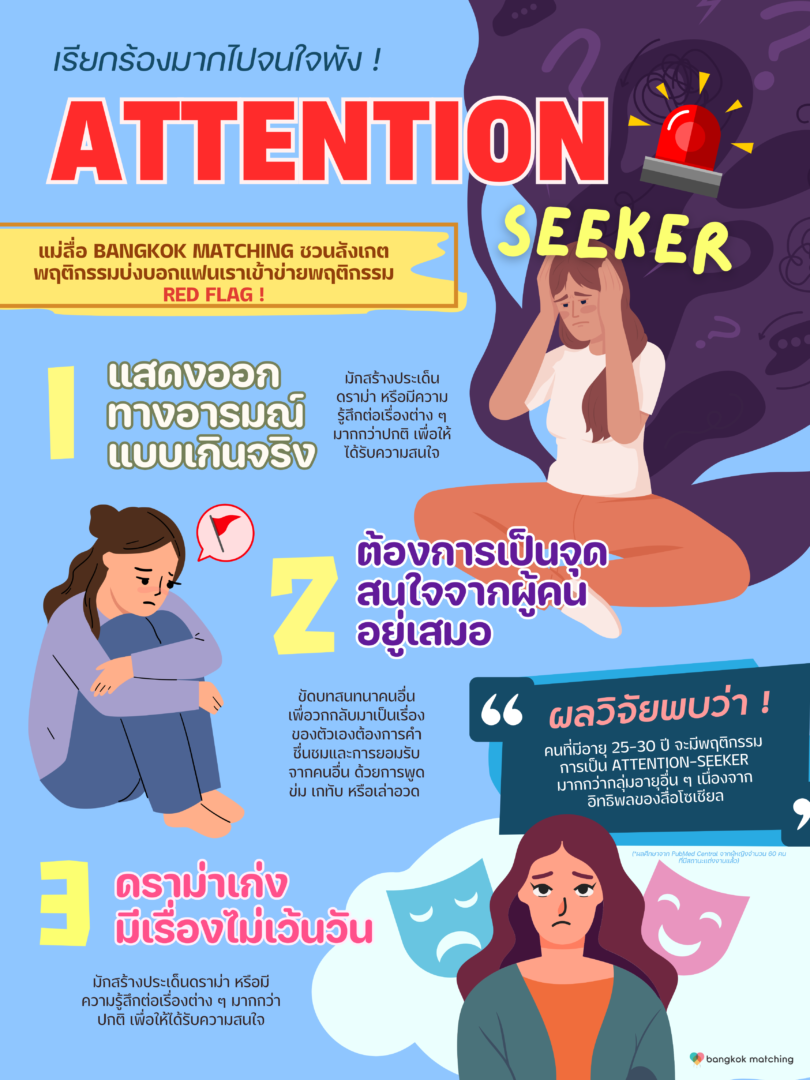Thai Dating Tips
Deep Dive into Relationships: What is Polyamory?
by Bangkok Matching
Today, Bangkok Matching, Thailand’s high-end matchmaking company, will delve into a specific type of relationship that, while not a novel concept, is gaining prominence in current discussions. This type of relationship challenges the conventional notion that love is reserved for two individuals. We are talking about “Polyamory.
Polyamory is a form of consensual non-monogamy where one person can have romantic, emotional, or sexual relationships with more than one person. The key aspect is that everyone involved in the relationship must have a shared understanding and agreement. It is not a recent phenomenon, but it has garnered increased attention, especially in recent times.
While Polyamory exists, it is not universally accepted. In some societies or regions, it is still considered unconventional, socially unacceptable, or against cultural norms. Even in Western societies, where such relationships are more visible, they may not be widely accepted. In Asian cultures, though there has been a gradual emergence of such relationships, they are not mainstream and may face societal resistance.
In Thailand, a survey conducted by Chiang Mai University explored public opinions on “Polyamory” relationships through online media. The findings revealed both positive and negative perspectives within the Thai society. Some view Polyamory as a way to avoid the stigma associated with infidelity, promoting a more ethical approach to relationships. On the other hand, critics perceive it as a violation of moral standards.
It is essential to note that, even in Thailand, Polyamory is not legally protected, and in many countries, marrying multiple partners is not legally recognized. The topic has sparked interest and debate, appearing in local news several times. Engaging in multi-partner relationships remains a legal gray area in numerous jurisdictions.
However, while Polyamory introduces a different perspective on relationships, its acceptance varies across cultures and societies. It challenges traditional views on monogamy and fidelity, opening a dialogue on diverse relationship structures. As society evolves, discussions around Polyamory will likely continue, prompting reflections on the boundaries and dynamics of modern relationships.

Furthermore, survey results from the YouGov US platform regarding legal rights for individuals in polyamorous relationships shed light on societal perspectives. More than 40% of respondents expressed disagreement, while an additional 30% remained uncertain. This suggests that, despite the perception that Western societies are generally open-minded, there is hesitancy or reluctance in fully embracing legally recognized rights for individuals in polyamorous relationships.
Even in societies where openness is often celebrated, the idea of legally acknowledging and protecting the rights of those engaged in polyamorous relationships is met with reservations. The data indicates that, when it comes to implementing legal measures, concerns and uncertainties persist among a significant portion of the population. This highlights the complex nature of societal attitudes towards relationships that deviate from traditional norms and underscores the ongoing challenges in achieving widespread acceptance and legal recognition for polyamorous unions.
Polyamory is Not the Same as Open Relationship
It’s crucial not to misunderstand that these two concepts are interchangeable, despite their apparent similarities. The key lies in a simple question: “Do you desire more love, or do you seek to enhance your sexual experiences?
In an Open Relationship, you may have one primary romantic partner but wish to explore new sexual experiences or engage in relationships without emotional attachment. The emphasis remains on having one significant romantic partner while allowing for additional experiences.
On the other hand, Polyamory involves seeking emotional connections and expanding feelings of love, with a focus on committed relationships. It goes beyond prioritizing sexual experiences and often entails having multiple partners who are all equally valued and involved. The number of partners can vary based on mutual agreements, and there is no hierarchy in terms of importance.
In Polyamory, each individual is considered an equal and integral part of the relationship, emphasizing shared love and commitment. The dynamics are not centered around sexual encounters but rather on forming meaningful connections and coexisting in a bonded relationship. It’s important to recognize and respect the distinct characteristics of these relationship styles.
Polyamory Differs from Polygamy – How?
Engaging in relationships with multiple partners, or polyamory, is distinct from the practice of polygamy, where individuals may have multiple spouses. Despite apparent similarities, these two relationship models differ significantly, and the key distinctions are as follows:
1 Marital Status:
-
- Polyamory: It is a form of consensual non-monogamy that does not involve legal marriage. Individuals in polyamorous relationships may have emotional, romantic, or sexual connections with multiple partners, but there is no formalized marriage structure.
- Polygamy: This is a marital arrangement where one individual has multiple spouses simultaneously. Polygamy can take various forms, such as polygyny (one man with multiple wives) or polyandry (one woman with multiple husbands).
2 Nature of Relationships:
-
- Polyamory: Involves consensual and often non-exclusive romantic or sexual relationships with multiple partners. There is an emphasis on emotional connections, and the relationships may or may not involve living together.
- Polygamy: Typically refers to a marriage structure where one person is legally married to multiple spouses. The relationships in polygamy are formalized through marriage, and the spouses may share a household.
3 Gender Dynamics:
-
- Polyamory: Is not restricted by gender and can involve individuals of any gender forming relationships with multiple partners.
- Polygamy: Traditionally involves a gender-specific dynamic, such as polygyny, where a man has multiple wives. Polyandry, where a woman has multiple husbands, is less common.
In summary, while both polyamory and polygamy involve multiple romantic or sexual connections, the crucial distinction lies in the legal and marital aspects. Polyamory emphasizes consensual relationships without formal marriage, whereas polygamy involves legally recognized marriage structures with multiple spouses.
Understanding the 7 Subtypes of Relationships in Polyamory
In the realm of polyamorous relationships, various configurations can emerge due to the inherent complexity and depth of human connections. Bangkok Matching, a reputable matchmaking company, exemplifies seven types of polyamorous relationships that are commonly observed. It’s crucial to note that the realm of polyamory encompasses a vast array of possibilities beyond these examples.
1 Triad:
-
- Originating from a couple seeking a compatible third individual, forming a group known as a “throuple,” involving three people. Starting with an existing couple often ensures greater stability and longevity. The woman who opens up to a pre-existing couple is sometimes termed a “unicorn,” while the man may be referred to as a “dragon,” reflecting the unique dynamics within their group.
2 Quad:
-
- Involves two existing couples joining together, creating a relationship structure involving four individuals. This form of polyamory is considered more enduring and long-lasting than forming entirely new pairs.
3 Vee:
-
- In this relationship structure, one person serves as the central axis, forming connections with two others who may not necessarily have a relationship with each other.
4 Solo Polyamory:
-
- Individuals engage as partners in existing relationships without having a primary partner of their own. This approach emphasizes independence and disregards hierarchical structures.
5 Polycule:
-
- Describes a relationship network where multiple connections intertwine, involving more than four to five individuals. Clear communication and mutual understanding are essential in such complex dynamics.
6 Hierarchical Poly:
-
- Participants agree on a hierarchical structure, with a primary couple defining roles and boundaries. The primary couple may decide the extent to which secondary couples engage with each other. This structure allows flexibility in forming relationships within the defined framework.
7 Polyfidelity:
-
- Couples collectively decide to limit their relationship circle, creating a closed relationship structure that is exclusive to selected members. Only those deemed eligible are allowed to join, and members commit to abstaining from forming relationships outside the established group.
Why People Are Interested in Polyamorous Relationships
Polyamorous relationships have gained attention due to the diverse and flexible nature they offer. Bangkok Matching, a high-end matchmaking company, identifies two main factors contributing to the growing interest in polyamory:
1 Desire for Diversity in Relationships: Polyamory provides individuals with the opportunity to engage in relationships with people who have different backgrounds, interests, and needs. This diversity allows individuals to feel fulfilled and enriched, as they can experience a variety of connections. Some view having multiple, varied love interests as a means to establish more enduring relationships compared to exclusive, monogamous relationships.
2 Need for Flexibility: Polyamorous relationships can be tailored to meet the specific needs and agreements of each individual and couple involved. This flexibility allows people to align their relationships with their personal preferences, reducing the feeling of being constrained. For those who are not comfortable with the idea of restricting love to one person, polyamory offers a sense of freedom and increased control over their relationship dynamics. It also helps minimize issues related to infidelity.
In summary, the appeal of polyamorous relationships lies in the potential for diverse and flexible connections, providing individuals with a sense of fulfillment, freedom, and the ability to tailor relationships to meet their unique needs and desires.
Flaws in Polyamorous Relationships
Polyamorous relationships undoubtedly come with various challenges. Even with pre-discussed agreements, it can be challenging to ensure that others will adhere to them faithfully and without reservations. The complexities in polyamorous relationships contribute to several drawbacks:
- Excessive Complexity: Polyamorous relationships continually intensify in complexity as more people and diverse needs are involved. The multitude of perspectives and the sometimes overwhelming agreements may surpass practicality, requiring meticulous management. Differing opinions make it difficult to enforce shared guidelines, leading to increased stress and anxiety. Monitoring the dynamics of each relationship constantly becomes a demanding task.
- Jealousy Issues: Jealousy is a common emotion in all relationships, but it can be heightened in polyamorous settings. The intricate nature of polyamorous relationships may evoke intense feelings of jealousy, as individuals may experience a variety of emotions and may feel overlooked or unloved by other partners. This negative sentiment can adversely impact mental and physical well-being.
- Social Pressures: Polyamorous relationships pose greater challenges than conventional relationships, as they are often not widely accepted or considered normal. Individuals in such relationships may feel isolated, pressured, or stressed due to societal expectations. The societal disapproval may create additional difficulties for those engaging in polyamorous relationships.
Considering these challenges, Bangkok Matching, with over 18 years of experience in providing relationship advice to clients in Thailand, emphasizes that polyamorous relationships are not widely embraced. While favored by some, they present significant complexities and fears compared to conventional relationships. The uncertainty of whether agreed-upon terms will be adhered to, coupled with potential emotional turmoil, raises concerns. Bangkok Matching advises individuals to carefully weigh the decision to enter into polyamorous relationships, as they can lead to significant future problems, including conflicts with partners, misunderstandings with family and friends, and potential moral dilemmas that may impact one’s professional life.
Ref:
https://so03.tci-thaijo.org/index.php/JHUMANS/article/download/243470/167871/877294
https://www.womenshealthmag.com/relationships/a19664033/polyamory-vs-open-relationships/
https://www.choosingtherapy.com/polyamory/





